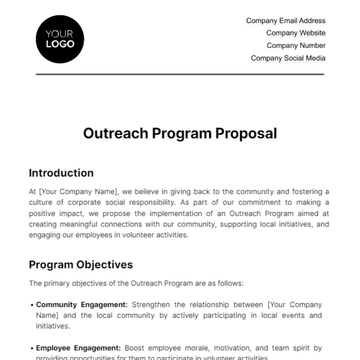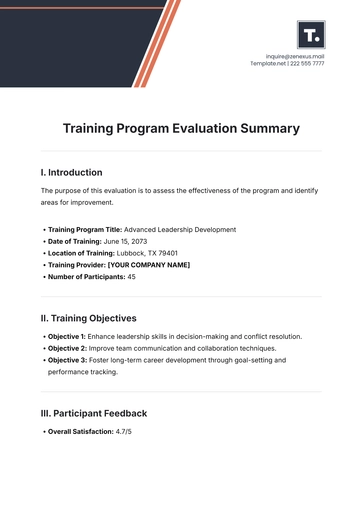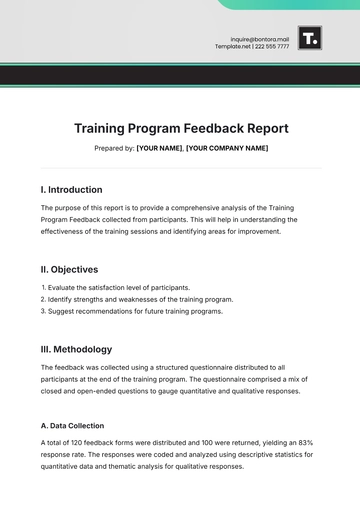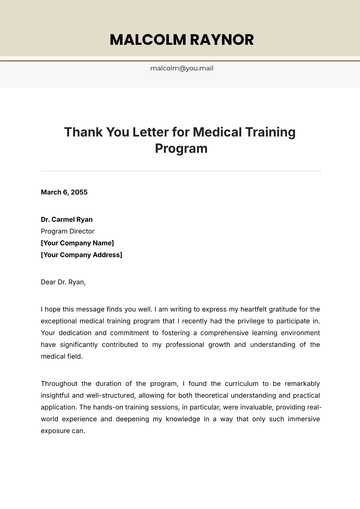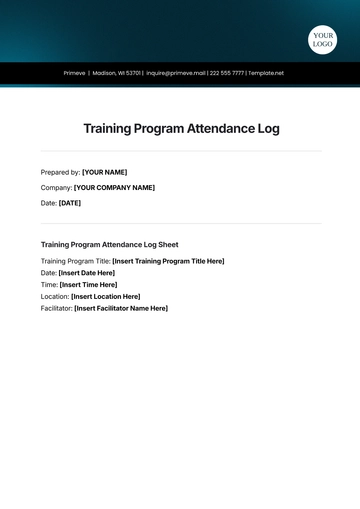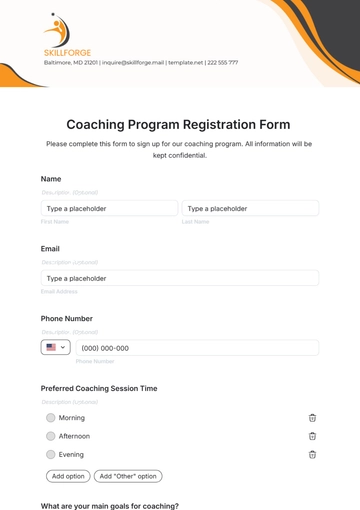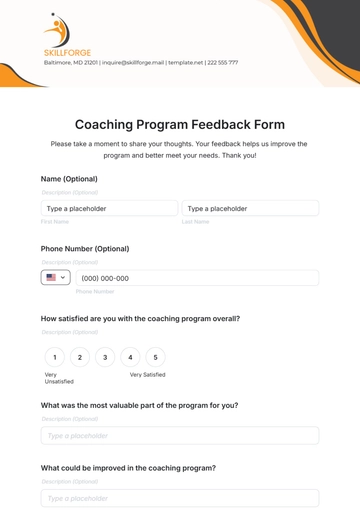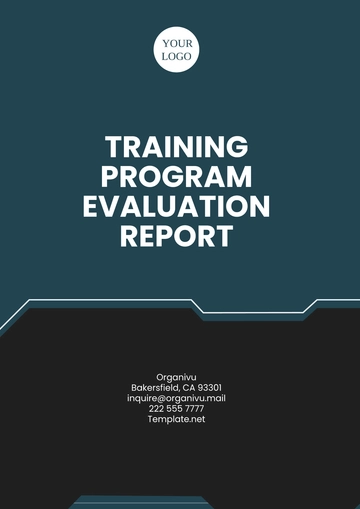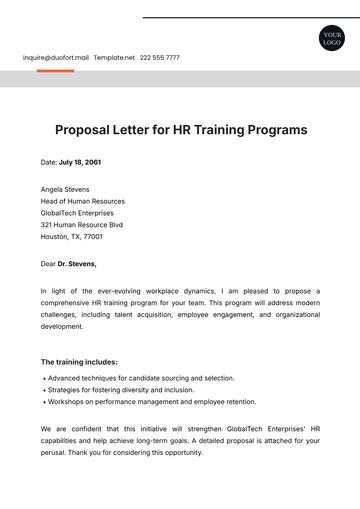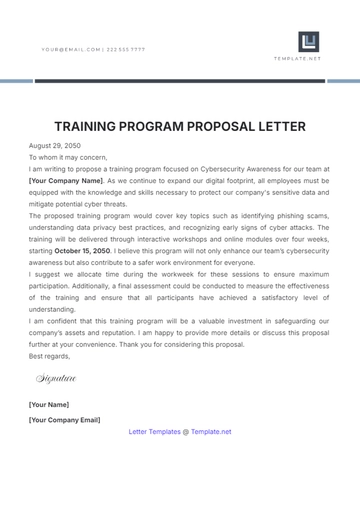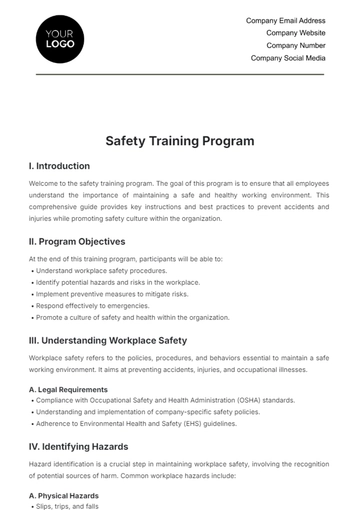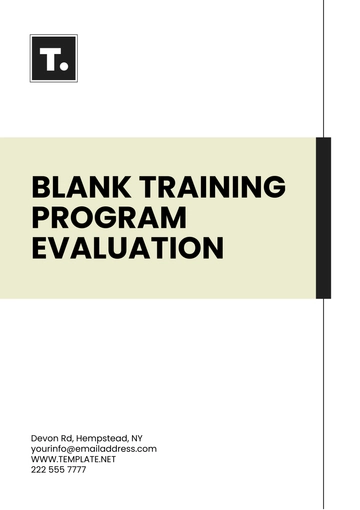Free Health & Safety Training Program Case Study

1. Executive Summary
[Your Company Name] is unwavering in its dedication to the safety and welfare of its employees. This Health & Safety Training Program Case Study encapsulates the meticulous strategy employed by [Your Company Name] in creating a resilient training program that meticulously caters to the health and safety requisites of our workforce.
In a world where safety is paramount, [Your Company Name] recognizes the vital role that effective training plays in safeguarding our employees. This case study provides a concise overview of our Health & Safety Training Program, designed to instill a culture of safety, reduce workplace incidents, and empower our workforce to respond effectively in emergency situations.
Our commitment extends to the continual refinement of our training program, ensuring it remains aligned with the latest safety regulations and industry best practices. By investing in the knowledge and skills of our employees, we pave the way for a safer and more secure workplace.
Through this comprehensive training initiative, [Your Company Name] is poised to not only meet but exceed industry standards in occupational health and safety. We remain steadfast in our mission to protect our employees, and we believe that a well-informed workforce is the cornerstone of a secure and productive work environment.
2. Introduction
[Your Company Name] recognizes the importance of providing effective health and safety training to its employees. This case study provides an overview of our Health & Safety Training Program, including its objectives, scope, design, implementation, and evaluation.
3. Objectives of the Health & Safety Training Program
In an ever-evolving work landscape, where the well-being of our employees is paramount, the Health & Safety Training Program of [Your Company Name] is designed with clear and concise objectives at its core. These objectives not only underscore our commitment to safety but also serve as the guiding principles that shape our training initiative.
Objective 1: Enhancing Awareness and Compliance
The first objective of our program is to ensure that all employees, regardless of their role or department, possess a profound awareness of safety regulations. We recognize that awareness is the bedrock upon which safe practices are built. By educating our workforce about the latest safety protocols and regulations, we aim to foster a culture of safety where compliance becomes second nature. This, in turn, minimizes the risk of workplace incidents and ensures the well-being of every team member.
Objective 2: Mitigating Workplace Incidents
Reducing workplace accidents and injuries is the pivotal second objective of our program. We understand that accidents can have far-reaching consequences, both for our employees and the organization as a whole. To address this, we have developed a comprehensive training curriculum that equips employees with the knowledge and skills necessary to identify and mitigate potential hazards. Our goal is to significantly decrease the occurrence of workplace incidents, thereby fostering a safer working environment for all.
Objective 3: Empowering Effective Emergency Response
In times of crisis, the ability to respond swiftly and effectively is crucial. Our third objective is to empower employees with the knowledge and skills necessary to respond to emergencies, such as fires, medical incidents, or natural disasters, with confidence and competence. Through specialized training modules, practical exercises, and hands-on experience, we aim to transform our workforce into a capable first line of defense during unforeseen events. This objective ensures not only the safety of our employees but also the resilience of our organization in the face of adversity.
These objectives collectively define the essence of our Health & Safety Training Program, reinforcing our commitment to creating a workplace where safety is not merely a policy but an ingrained value upheld by every member of our team.
4. Scope of the Training Program
In defining the scope of our Health & Safety Training Program, [Your Company Name] has taken a comprehensive approach to ensure that it addresses the critical aspects necessary to maintain a secure and hazard-free workplace. The scope of our program encapsulates a wide array of key areas, each meticulously designed to empower our employees with the knowledge and skills they need to navigate potential risks confidently.
1. Occupational Health and Safety Regulations
The first pillar of our training program centers on equipping employees with a deep understanding of occupational health and safety regulations. In a dynamic regulatory landscape, staying compliant is paramount. Our program delves into the intricacies of these regulations, ensuring that our workforce is not only aware of them but also adept at adhering to them in their daily tasks.
2. Occupational Health and Safety Regulations
To mitigate potential workplace hazards, our program focuses on hazard identification and risk assessment. We recognize that proactive risk management is the key to preventing accidents and injuries. Through this training, employees learn how to identify potential hazards, assess their risks, and take appropriate preventive measures.
3. Occupational Health and Safety Regulations
In times of crisis, preparedness is essential. Our training program includes comprehensive emergency response procedures that guide employees on how to react effectively during emergencies, such as fires, medical incidents, or natural disasters. We emphasize the importance of quick and informed responses to minimize harm and protect lives.
4. First Aid and CPR Training
To provide immediate assistance in medical emergencies, our program includes First Aid and CPR training. Employees acquire vital skills to administer immediate care, potentially saving lives in critical situations. This training ensures that our workplace is equipped with a first line of defense in medical emergencies.
5. Personal Protective Equipment (PPE) Usage
The correct use of Personal Protective Equipment (PPE) is imperative in many work environments. Our program educates employees on the types of PPE available, when and how to use them, and their role in safeguarding against workplace hazards. This knowledge ensures that employees are well-equipped to protect themselves while performing their duties.
6. Safety Reporting and Incident Management
Our program concludes with a comprehensive module on safety reporting and incident management. It is essential that employees know how to report safety concerns and incidents promptly. Through this training, we establish a structured system for reporting and managing incidents, fostering a culture of transparency and accountability.
The scope of our Health & Safety Training Program reflects our unwavering commitment to providing a well-rounded and holistic approach to safety. By addressing these critical areas, we aim to create a workplace where every employee is not only informed but also actively engaged in maintaining a safe and secure environment.
5. Training Needs Analysis
Our Health & Safety Training Program is underpinned by a thorough Training Needs Analysis (TNA), which serves as the cornerstone of our training strategy. This analysis not only validates the necessity of our program but also guides its content and delivery.
Data Sources
The TNA draws insights from a variety of sources to ensure comprehensiveness and accuracy:
Incident Reports: The foundation of our analysis is incident reports. These documents capture past workplace incidents, near-misses, and accidents. By dissecting these reports, we identify recurring patterns and trends, shedding light on areas where safety improvements are urgently needed.
Employee Surveys: The voices of our employees matter deeply. We conduct surveys to gather their perspectives on safety concerns and training needs. This employee feedback is invaluable in understanding the real-world challenges and expectations that shape our training curriculum.
Industry Benchmarks: To align with best practices and industry standards, we conduct benchmarking against peer organizations and industry leaders. This external perspective helps us identify areas where we can excel and sets benchmarks for our own safety standards.
The Training Needs Analysis Process
The TNA process at [Your Company Name] is structured and systematic:
Data Collection: Incident reports and employee survey data are collected, collated, and meticulously analyzed. This stage involves both quantitative and qualitative analysis to identify trends and specific training gaps.
Identification of Training Gaps: Based on the data, specific training gaps are pinpointed. These gaps encompass a wide range of areas, from regulatory compliance issues to practical skills shortages.
Prioritization: Not all identified gaps are equal in their impact. Our analysis prioritizes training needs based on their potential for risk mitigation and the urgency of addressing them.
Curriculum Design: The findings of the TNA directly inform the design of our training curriculum. Modules are tailored to address the identified gaps, ensuring that our training is not only relevant but also responsive to real-world challenges.
Table: Prioritized Training Needs
Training Need | Priority Level | Rationale |
Hazard Identification | High | High incidence of accidents related to unidentified hazards. |
Emergency Response Skills | Medium | Employee surveys indicate a need for improved emergency response preparedness. |
First Aid and CPR Training | High | Critical in addressing workplace medical emergencies. |
PPE Usage and Compliance | Medium | Ensuring consistent and proper use of PPE. |
Safety Reporting Procedures | High | Increase in the reporting of incidents and near-misses. |
By conducting this thorough Training Needs Analysis, [Your Company Name] ensures that our Health & Safety Training Program is finely tuned to address the most pressing safety concerns. Our commitment to data-driven decision-making ensures that our program is not just a theoretical exercise but a practical solution to protect our employees and maintain a secure workplace.
6.Program Design
In the development of our Health & Safety Training Program, [Your Company Name] places a premium on precision and effectiveness. This chapter delves into the meticulous design of our training initiative, which stands as a testament to our commitment to providing our employees with the knowledge and tools necessary to navigate the intricacies of workplace safety.
Our approach to program design is rooted in a deep understanding of the multifaceted nature of safety training. We recognize that it's not enough to simply disseminate information; it must be done in a manner that is engaging, adaptable, and comprehensible to a diverse workforce. As such, this chapter explores the core components that underpin the program, including the training modules, materials, methods, and schedule.
Through the careful calibration of these elements, [Your Company Name] endeavors to create a training experience that not only imparts knowledge but also instills a culture of safety. By the end of this chapter, you will gain insight into how our training program is finely tuned to meet the unique needs of our workforce, ensuring that every employee is equipped with the skills and awareness needed to thrive in a safe and secure workplace.
Program Design | Details |
Training Modules | Module 1: Introduction to Health & Safety Module 2: Hazard Identification and Risk Assessment Module 3: Emergency Response Procedures Module 4: First Aid and CPR Training Module 5: Personal Protective Equipment (PPE) Module 6: Safety Reporting and Incident Management |
Training Materials | Training materials include presentations, manuals, and videos. These materials are regularly updated to reflect the latest safety regulations and best practices. |
Training Methods | The training program incorporates a combination of classroom training, hands-on exercises, and online learning modules to cater to different learning styles. |
Training Schedule | The program will be conducted quarterly, with mandatory sessions for all employees. |
7. Resources and Personnel
At [Your Company Name], we understand that the effectiveness of our Health & Safety Training Program hinges on the competence of our trainers and the availability of appropriate resources. This chapter delves into the critical aspects of resources and personnel that contribute to the success of our training initiative.
Qualified Trainers and Subject Matter Experts:
Central to the success of our training program are our qualified trainers and subject matter experts. We handpick individuals who not only possess expertise in their respective domains but also have a passion for imparting knowledge. These professionals bring real-world experience and in-depth understanding to the training sessions, ensuring that the content is not just theoretical but also practical and relevant.
Our subject matter experts are well-versed in the intricacies of safety regulations, hazard identification, emergency response procedures, and other critical aspects of workplace safety. Their expertise enables them to provide nuanced guidance and practical insights that resonate with our diverse workforce. Through their guidance, we instill confidence in our employees, empowering them to proactively manage safety in their day-to-day tasks.
Adequate Training Facilities and Equipment:
To facilitate effective learning, [Your Company Name] spares no effort in providing adequate training facilities and state-of-the-art equipment. We recognize that hands-on experiences and practical simulations are invaluable in promoting a deep understanding of safety principles. Therefore, our training facilities are equipped with the latest tools and resources necessary for hands-on exercises and simulations.
Our commitment to ensuring that employees have access to the right equipment extends to Personal Protective Equipment (PPE) as well. We provide employees with the necessary safety gear, fostering a culture of PPE compliance and safety consciousness.
8. Program Implementation
The implementation phase of our Health & Safety Training Program marks a pivotal moment in our commitment to ensuring a secure and well-informed workforce. Commencing on [Month Day Year], this program will be mandatory for every member of our organization. The universality of this mandate reinforces our unwavering commitment to the safety and well-being of all employees, irrespective of their roles or departments.
Attendance records will be meticulously maintained throughout the program to track participation and ensure that each employee completes the requisite training. This commitment to record-keeping not only helps in monitoring compliance but also enables us to identify any potential gaps or areas that require additional support. As we move forward in this implementation phase, our collective goal is to create a workplace where every employee is not only aware of safety protocols but is also equipped to apply them effectively in their daily tasks, thus ensuring the highest standards of occupational safety and well-being.
9. Monitoring and Evaluation
Key Performance Indicators (KPIs): Our approach to monitoring and evaluating the Health & Safety Training Program centers on the meticulous tracking of key performance indicators (KPIs). These KPIs encompass various aspects, including accident rates, incident reports, and valuable employee feedback. By consistently monitoring these metrics, we gain real-time insights into the program's impact on safety within our organization. This data-driven approach enables us to swiftly respond to emerging trends and make informed decisions to enhance safety further.
Data Collection and Analysis: Integral to our evaluation process is the regular collection and in-depth analysis of data. We recognize that the effectiveness of the training program hinges on the ability to assess its impact objectively. Therefore, we diligently collect relevant data and subject it to thorough analysis. This data-driven approach ensures that we have a comprehensive understanding of the program's strengths and areas that require improvement. With these insights, we can make informed adjustments to the program as needed, ensuring its continued relevance and effectiveness.
Continuous Improvement: At [Your Company Name], our commitment to safety extends to a dedication to continuous improvement. We understand that maintaining a safe work environment is an evolving process. As such, we pledge to make any necessary changes to enhance the program's effectiveness continually. These adjustments are based on findings from data analysis, employee feedback, and emerging best practices in the field of occupational health and safety. Through this commitment to improvement, we aim to uphold the highest standards of safety and well-being for our workforce.
10. Budget Allocation
In order to bring our comprehensive Health & Safety Training Program to life, prudent allocation of resources is imperative. This chapter provides a breakdown of the budget allocation, detailing how the allocated funds will be utilized to ensure the success and sustainability of our program.
Table: Budget Allocation Details
Budget Item
Allocation Amount
Description
Training Materials
[$000.00]
Funds allocated for the development, procurement, and maintenance of training materials, including manuals, videos, and presentations.
Personnel
[$000.00]
Allocation for qualified trainers and subject matter experts responsible for delivering training sessions.
Facilities
[$000.00]
Budget set aside for the provision and maintenance of suitable training facilities, ensuring a conducive learning environment.
Equipment
[$000.00]
Funds allocated for the acquisition and maintenance of necessary training equipment, including simulation tools and safety gear.
11. Conclusion
[Your Company Name] is dedicated to ensuring the safety of its employees through the implementation of a comprehensive Health & Safety Training Program. We are committed to providing ongoing training and support to create a safe and secure work environment.
12. Appendix A: Training Schedule
[Include the detailed training schedule here]
13. Appendix B: Training Materials
[Include samples of training materials]
14. Appendix B: Training Materials
[Provide detailed metrics and data collection methods]
For more information, please contact:
[Your Name]
[Your Email]
[Your Company Number]
- 100% Customizable, free editor
- Access 1 Million+ Templates, photo’s & graphics
- Download or share as a template
- Click and replace photos, graphics, text, backgrounds
- Resize, crop, AI write & more
- Access advanced editor
Unlock insights and best practices with Template.net's Health & Safety Training Program Case Study Template. This editable and customizable tool offers a structured format for documenting successful training initiatives. Utilize our intuitive Ai Editor Tool to tailor the case study to your organization's specific needs effortlessly, facilitating knowledge sharing and continuous improvement.

